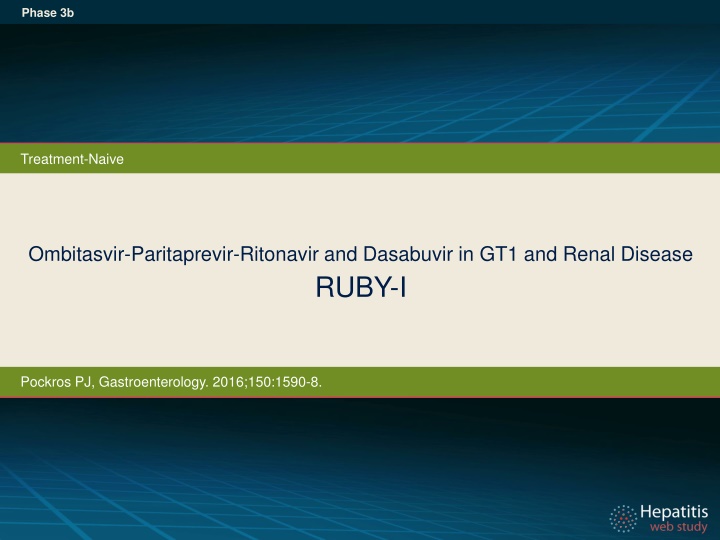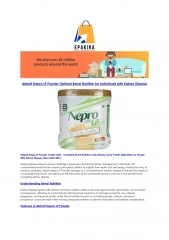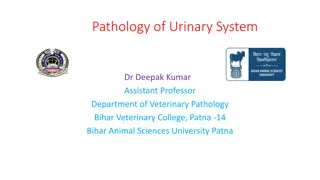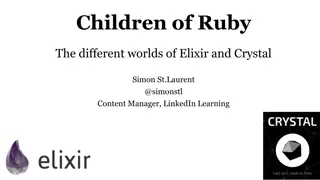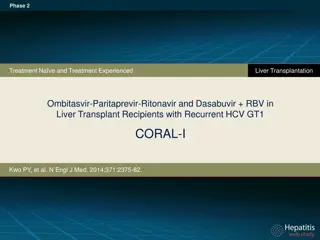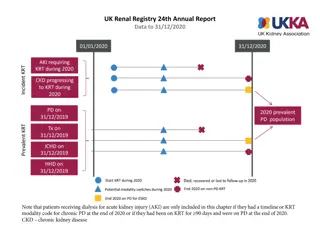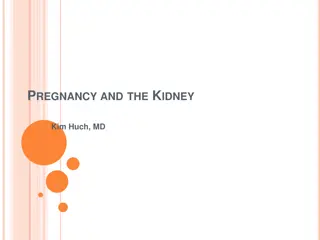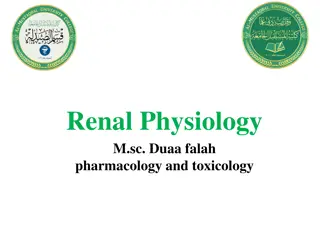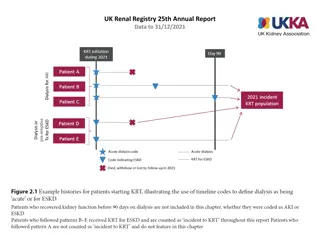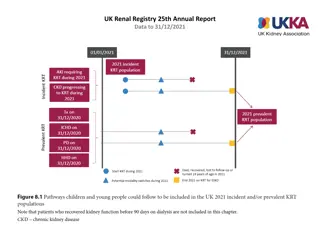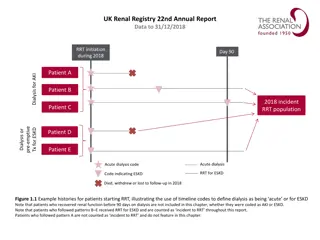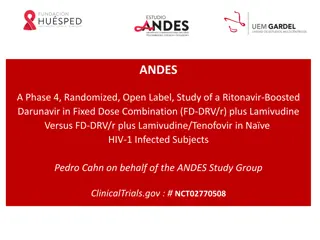Ombitasvir-Paritaprevir-Ritonavir and Dasabuvir in GT1 & Renal Disease RUBY-I Study
This study focuses on the safety and efficacy of Ombitasvir-Paritaprevir-Ritonavir and Dasabuvir in treatment-naive patients with chronic HCV GT1 and advanced kidney disease. It delves into the study design, regimens, baseline characteristics, and results like SVR rates. The drug dosing and patient criteria are also outlined. The research, published in Gastroenterology, presents key insights into the treatment of HCV in patients with renal disease.
Download Presentation

Please find below an Image/Link to download the presentation.
The content on the website is provided AS IS for your information and personal use only. It may not be sold, licensed, or shared on other websites without obtaining consent from the author.If you encounter any issues during the download, it is possible that the publisher has removed the file from their server.
You are allowed to download the files provided on this website for personal or commercial use, subject to the condition that they are used lawfully. All files are the property of their respective owners.
The content on the website is provided AS IS for your information and personal use only. It may not be sold, licensed, or shared on other websites without obtaining consent from the author.
E N D
Presentation Transcript
Phase 3b Treatment-Naive Ombitasvir-Paritaprevir-Ritonavir and Dasabuvir in GT1 and Renal Disease RUBY-I Pockros PJ, Gastroenterology. 2016;150:1590-8.
Ombitasvir-Paritaprevir-Ritonavir and Dasabuvir in GT1 & Renal Disease RUBY-I: Study Design RUBY-I: Features Design: Phase 3b, randomized, open-label trial evaluating safety and efficacy of 3D (ombitasvir-paritaprevir-ritonavir and dasabuvir) with or without ribavirin for 12 weeks in treatment-na ve patients with chronic HCV GT1 and advanced kidney disease Setting: 9 sites in United States Entry Criteria - Adults with chronic HCV genotype 1 infection - Chronic kidney disease stage 4 or 5 (eGFR <30 mL/min/1.73 m2) +/- HD - Plasma HCV RNA greater than 1,000 IU/mL - Absence of cirrhosis - Absence of coinfection with HBV or HIV - Baseline Hb 10 g/dL Primary End-Point: SVR12 Source: Pockros PJ, Gastroenterology. 2016;150:1590-8.
Ombitasvir-Paritaprevir-Ritonavir and Dasabuvir in GT1 & Renal Disease RUBY-I: Regimens Week 0 12 24 Ombitasvir-Paritaprevir-Ritonavir and Dasabuvir + Ribavirin GT 1a n = 13 SVR12 Ombitasvir-Paritaprevir-Ritonavir and Dasabuvir GT 1b n = 7 SVR12 Drug Dosing Ombitasvir-Paritaprevir-Ritonavir (25/150/100 mg once daily) + Dasabuvir: 250 mg twice daily Ribavirin for patients not on hemodialysis: 200 mg once daily Ribavirin for patients on hemodialysis: 200 mg given 4 hours before each hemodialysis session Source: Pockros PJ, Gastroenterology. 2016;150:1590-8.
Ombitasvir-Paritaprevir-Ritonavir and Dasabuvir in GT1 & Renal Disease RUBY-I: Baseline Characteristics Baseline Characteristic All Patients (n = 20) Male, % Median age, years (range) Race Black Hispanic Median HCV RNA, log10 IU/ml (range) Degree of Fibrosis, n (%) F0-F1 F2 F3 CKD Stage; n (%) 4 (eGFR 15-30 mL/min/1.73 m2) 5 (eGFR <15 mL/min/1.73 m2 or requiring HD) eGFR, mL/min/1.73 m2 17 (85%) 60 (49-69) 14 (70%) 3 (15%) 6.6 (5.5-7.6) 10 (50%) 6 (30%) 4 (20%) 6 (30) 14 (70) 10.9 (5.4-29.9) Source: Pockros PJ, Gastroenterology. 2016;150:1590-8.
Ombitasvir-Paritaprevir-Ritonavir and Dasabuvir in GT1 & Renal Disease RUBY-I: Baseline Results RUBY-I: SVR 12 Rates* GT1a: OBV/PTV/r + DSV + RBV GT1b: OBV/PTV/r + DSV 100 100 100 100 100 Virologic Response 80 85 85 60 40 20 85/88 91/91 13/13 7/7 11/13 7/7 11/13 7/7 0 EOT SVR4 SVR12 OBV/PTV/r + DSV = Ombitasvir-Paritaprevir-Ritonavir and Dasabuvir; RBV = ribavirin Source: Pockros PJ, Gastroenterology. 2016;150:1590-8.
Ombitasvir-Paritaprevir-Ritonavir and Dasabuvir in GT1 & Renal Disease RUBY-I: Conclusions Conclusions: In a clinical trial, the combination of ombitasvir, paritaprevir, and ritonavir, administered with dasabuvir, led to an SVR12 in 90% of patients with HCV genotype 1 infection and stage 4 or 5 CKD. The regimen is well tolerated, though ribavirin use may require a reduction or interruption to manage anemia. Source: Pockros PJ, Gastroenterology. 2016;150:1590-8.
This slide deck is from the University of Washingtons Hepatitis C Online and Hepatitis Web Study projects. Hepatitis C Online www.hepatitisc.uw.edu Hepatitis Web Study http://depts.washington.edu/hepstudy/ Funded by a grant from the Centers for Disease Control and Prevention.
